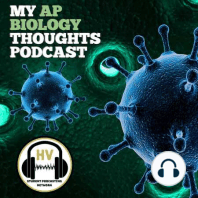11 min listen

Evolutionary Relationships: Phylogenetic Trees and Cladograms
Evolutionary Relationships: Phylogenetic Trees and Cladograms
ratings:
Length:
5 minutes
Released:
Jan 15, 2021
Format:
Podcast episode
Description
My AP Biology ThoughtsWelcome to My AP Biology Thoughts podcast, my name is Charles but you can call me Darwin and I am your host for today. This is podcast number 8 called Evolutionary Relationships. Today we will be discussing Phylogenetic trees and Cladograms.Segment 1: Introduction to Evolutionary RelationshipsPhylogenetic Tree- A diagram that shows evolutionary relationships among species Uses DNA sequences to find patterns in speciesThere is a distinct difference between cladograms and phylogenetic trees. Cladograms are shaped like a “y” but with a lot more lines branching off. This diagram is based on hypothesis and does not use DNA sequencing. It’s mainly based on homologous structures and noted similarities between animales. Each protruding line from the base represents a time where a structure split off, such as a heart having 4 chambers or having webbed feet. Phylogenetic trees are mainly used to show time. It is shaped like a very geometric tree sideways. The trunk is the common ancestor for all of the species at the tip of the branches. Each junction represents a closer common ancestor. If a line stops short, that usually means the species went extinct.Cladograms-DNA sequencing is a process of finding common ancestors. Since All cells have DNA, which contain a series of different letters that describe that organism. If some of the sequences in DNA matches that of another species, that could mean they are related or share a common ancestor. are different ways to find the common ancestor of a species, one way is to find homologous bones structures in creatures, which could relate species. However, the most definitive way to find common ancestors, is to look at similarities in DNA sequences. Segment 2: Example of Phylogenetic Trees and CladogramsThere are tons of examples, and you can search up a diagram for any animal. Looking at a human Phylogenetic tree, we can see that humans are more closely related to chimpanzees than any other monkey. Also, Humans are more closely related to cats, than cows. In addition to looking at phylogenetic trees, you could look at similarities in DNA sequences. Cats are 85% similar to humans, while cows are about 80% similar. It doesn’t seem like cats should be my brothers, however that remaining 15% has critical DNA letters that change various aspects of a creature. If we were to look at a cladogram, we would see the line for humans would be separate from cats, and the segment in between would represent a time where fur stops being useful or hind legs are being primarily used. Segment 3: Digging Deeper and Making ConnectionsHow does this topic fit into the greater picture of evolution?Cladograms and Phylogenetic trees come hand in hand when determining common ancestors. These common ancestors are the key to seeing how the species was able to evolve and split off into different organisms. While cladograms help us determine specific structures and when organisms split off, they are not scientific....
Released:
Jan 15, 2021
Format:
Podcast episode
Titles in the series (100)
Hardy-Weinberg Theory by My AP Biology Thoughts